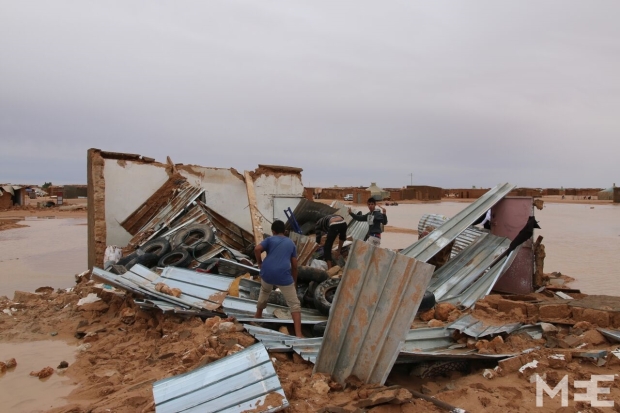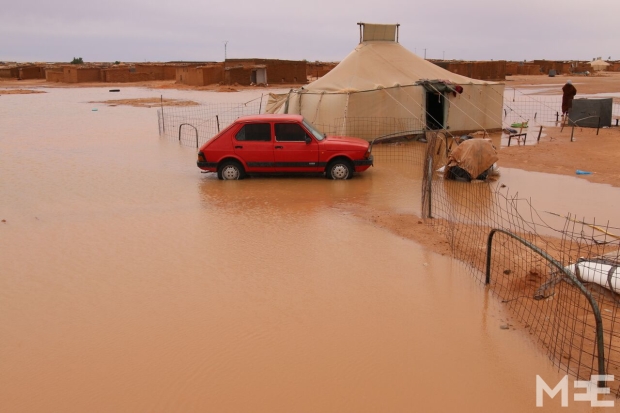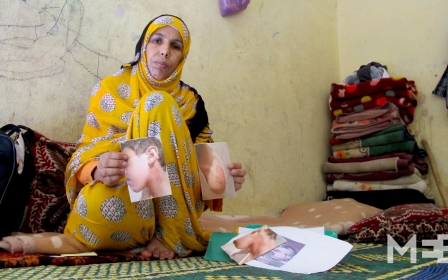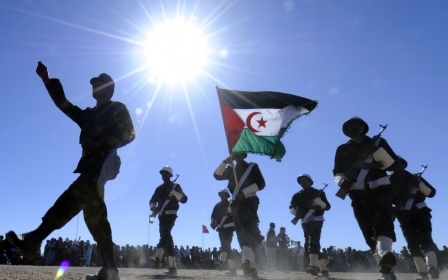Heavy rains wash away homes and hope for Western Sahara refugees

TINDOUF, Algeria – Heavy rains have been pounding much of North Africa and the Middle East, bringing destruction in their wake and causing heavy flooding, but the torrential downpours have taken a particularly heavy toll on the vulnerable refugee community in Algeria’s Tindouf province.
“I’m just grateful for the safety of my children,” Fatima Omar says as she stands, still in shock, outside of her now destroyed mud-brick house in Smara Refugee Camp in Algeria’s Tindouf province.
“The rain started early last week, it was just the usual light rain that we have from time to time,” Omar told Middle East Eye. “But last Thursday evening it suddenly started to get harder, the house started leaking. By three in the morning I started to hear the loud sound of collapsing bricks.”
Smara Refugee Camp, is one of several refugee camps in Algeria’s Tindouf province. The province houses more than 165,000 Western Sahrawi refugees, of which 90,000 are under direct UNHCR care.
During the Western Sahara War of 1975-76, Moroccan forces advanced on Western Sahara as Spain, which had colonised the area for nearly a century, withdrew from the region. Despite Western Sahrawi claims for self-determination, Morocco began what has become a four-decade occupation of Western Sahara. The war sent tens of thousands of Sahrawi refugees fleeing into Algeria. While many believed their stay would be temporary, 40 years later many continue to live in crudely created and vulnerable forms of shelter, including tents and mud-brick homes.
Despite the refugee situation of the Sahrawi people being one of the most protracted in the world, there is very little solid infrastructure in place. When heavy rain hit Tindouf last week, 5,000 families or 25,000 people were directly affected, while several hospitals, latrines, and schools have been destroyed or partially washed away.
Many houses in Smara no longer have four walls. Gaping holes where bricks have been washed away scar many of the buildings that were lucky enough to have remained standing in some form. Piles of soggy mud bricks and twisted corrugated metal show the remains of completely collapsed homes. Children play in the debris unaware of the reality their parents are now faced with, while those parents watch on, trying to figure out how to rebuild, and quickly, before winter closes in.
Mohamed Fadal, a 51-year-old Sahrawi living in Bojdour Refugee Camp, told MEE he had tried to prepare for potential flash flooding. When first building his mud-brick he opted to build it on a hill where the thought it would be safe.
“I thought [building there] that I had nothing to worry about when it came to rain,” Fadal says. “But apparently I was wrong.”
Fadal, like Omar, now lives in a tent with his wife and four children. His home was destroyed within hours as heavy rain beat down on Bojdour and its mud-brick homes.
“I was more concerned about floods,” Fadal says in disbelief. “On the top of the hill there was no possibility of floods, [but] sustained heavy rain caused cracks in the top of my house, it rained all day and night. In the morning I saw cracks in the whole building, I knew then that it was not going to hold up.”
The Tindouf region is known as the Devil’s Garden for its fierce sand storms and gruelling summer heats that can reach 50C, but the area is no stranger to heavy rains. In February 2006, similar downpours caused flooding which destroyed much of the Sahrawi camps in the region. Some 50,000 Sahrawi refugees in the camps were made homeless and in urgent need of aid. One woman was reportedly killed and several people injured.
“I watched the total collapse of the whole building,” Omar says while talking about her home. “My biggest fear was my children’s safety, the houses falling down could have killed them.”
Now homeless, and living in a tent, Omar still appears in shock at the loss of her home. “It was a terrifying nightmare that I hope no-one else will ever experience,” she says.
There is a growing sense of frustration in the camps, not just at the current devastation, but what refugees say is a feeling of recurring abandonment. Four decades since fleeing war, Sahrawis remain in a dire situation with little hope of returning to their homeland. For many there is a belief that Western Sahara is a forgotten occupation, and the Sahrawis of Tindouf, forgotten refugees.
“The international community needs to act and enable us the right of self-determination to end this vicious cycle in our lives,” Omar says when asked about life as a Sahrawi in the camps. The 48-year-old's frustration is deep-seated, and has been four decades in the making. To her, the recent torrential rain feels like just the latest in a string of events that have befallen Western Sahrawi refugees like herself.
While tents, food, blankets and plastic sheets have been airlifted into Tindouf’s barren and harsh desert landscape, the UNHCR is worried that health and sanitation problems could become a problem if infrastructure is not repaired quickly. It has launched an urgent appeal for emergency funds, but the international community has traditionally proven either slow or unwilling to loosen the purse strings when it comes to Western Saharan refugees.
“UNHCR’s 2015 budget for the Tindouf operation is around just 20 percent, leaving a huge funding gap and restricting operational activities,” Melissa Fleming, the spokesperson for the UNHCR explained in regards to the need for funding to help in the aftermath. “Although there is little rain in the Sahara for most of the year, when it does come it can be devastating, especially for mud-brick constructions.”
With few funds and little access to other parts of Algeria, the refugee population has had to rely on cheap building materials that can be sourced locally rather than more expensive concrete bricks that can cost four times as much.
Fadal works in a small school in Smara Refugee Camp where he works as a cook earning the equivalent of around $5 a day. With winter approaching he says he is worried about what the future holds. “I don’t know what to do,” he says. “My hope is to be able to build two rooms and a bathroom using cement-bricks instead of mud bricks, but I don’t have the money as I only make $120 a month. The cost of rebuilding my home is $1,400.”
Fadal now believes that he will be living in a tent for sometime but his situation is not unique. For Omar and her family, the future looks depressingly similar.
“This is a reminder of how vulnerable our situation is,” Omar says while explaining that she does not want to build a permeant home in the camp. “This land is not even ours.”
Fighting for the self-determination of Western Sahara, and being able to live in her homeland, remains her driving force.
“The future now is difficult to predict. But 40 years is more than enough for them [the international community] to pressure Morocco into respecting international law. We have waited too many years.”
Middle East Eye propose une couverture et une analyse indépendantes et incomparables du Moyen-Orient, de l’Afrique du Nord et d’autres régions du monde. Pour en savoir plus sur la reprise de ce contenu et les frais qui s’appliquent, veuillez remplir ce formulaire [en anglais]. Pour en savoir plus sur MEE, cliquez ici [en anglais].






